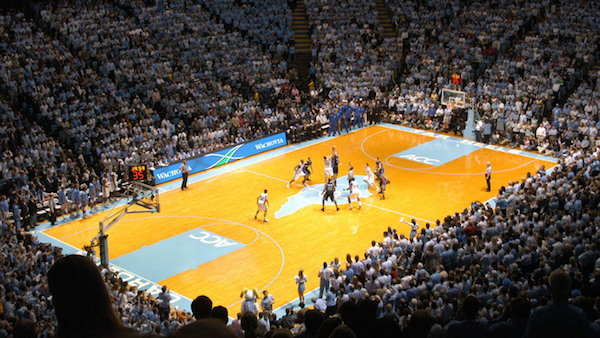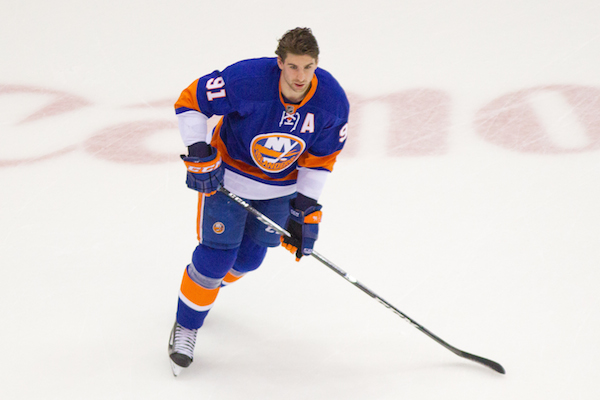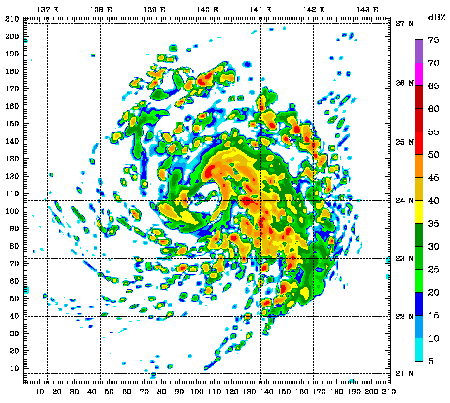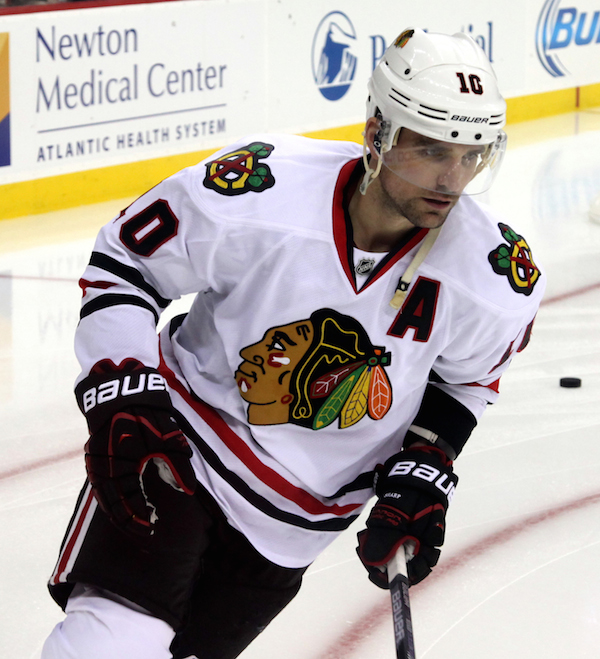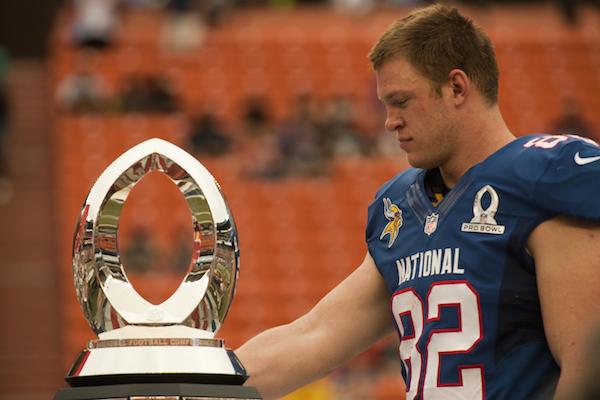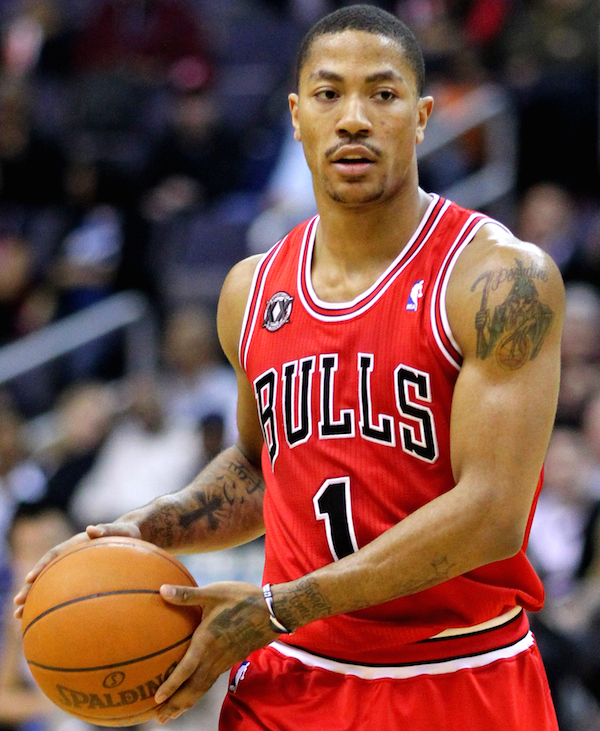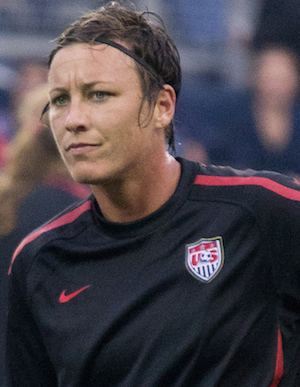- Chelsea leave Paris happy: Two legged playoffs like the Champions League are such that the visiting team is happy to come away with a tie in the first game, especially if it’s not a scoreless tie. This is because the first tie-breaker in case the two teams are even on goals after their second game is how many goals the team scored as a visitor. After yesterday’s 1-1 tie against PSG, Chelsea has the upper hand.
Line: When is a tie a win? When it’s the first half of a two-leg playoff. - 5-1 but not that lopsided: The Nashville Predators beat the San Jose Sharks 5-1 last night but the game was not nearly as lopsided as it appears from that score. Nashville’s goalie, Pekke Rinne, made 42 saves. That’s a lot of saves! If the Predators didn’t have one of the best goalies in the world on their team, they still may have won, but the score would probably have been 5-3 or 5-4.
Line: Having a great goalie is the most important thing in hockey. - St. John’s Law: They may not quite be up to the standard of Murphy, but it did seem like anything that could go wrong for St. John’s last night in their game against Georgetown, did. The St. John’s team ended the game limping and losing, 79-57.
Line: Coming in with a three game winning streak, I expected more from St. John’s.
What's the lesson of the greatest NBA shot ever?
Yesterday I was listening to the most recent episode of Bill Simmons’ BS Report podcast. This was a multi-part episode with Simmons interviewing a number of NBA figures, including Miami Heat starter Chris Bosh. Bosh was a member of the so-called Big Three in Miami along with LeBron James and Dwayne Wade, who went to four straight NBA Finals and won two. Bosh and Simmons were discussing a pivotal moment in the Heat’s 2012-13 Championship run – a last second, game tying three point shot by Ray Allen. Simmons and Bosh, sports writer and player alike were marveling at Ray Allen’s obsession with practice. Allen, they said, was perhaps the only person in the NBA who had actually practiced, over and over again, the precise footwork and body positioning required for that exact situation.
Before we get to what they said about it, let’s set the scene quickly for those of you who don’t know the moment they’re talking about. The NBA Finals is a best four out of seven game series. The San Antonio Spurs were up three games to two entering into the sixth game. After three quarters, the Spurs led 75-65. A ten point lead is not insurmountable, but it’s not easily dismissed either. The pressure had to have been enormous on the Heat. They were at home, in Miami, knowing that if they lost this game, they would lose the series and their season would be over. With nineteen seconds left, the Spurs were clinging onto a three point lead but Miami had the ball. Their best player, LeBron James, took a three point shot to tie the game but it hit the rim and did not go in. Chris Bosh, the subject of Simmons’ interview, was in the right spot and grabbed the rebound. As he caught the ball, his teammate Ray Allen who was also trying to get the rebound, was in virtually the same spot on the floor as him, in the paint, right near the basket. As Allen sees Bosh catch the ball, he quickly takes four or five running steps backwards, without turning his body from Bosh. Bosh passes Allen the ball. Allen Catches as he is running backwards, stops right in the three feet or so of room between the three-point line and the out-of-bounds line, and without touching either, he shoots the ball and makes a three point shot to tie the game. It’s an amazing play. Watch it here:
Now back to the BS Report. Here’s how the conversation went:
Chris Bosh: You never know when you’re gonna shoot a back-pedal three in the corner.
Bill Simmons: I really think it was the greatest shot ever because I think he’s the only person who would ever practice the footwork it took to go backwards and not go out of bounds. I don’t even know who else would have thought to practice that.
Bosh: That showed me that you should work on everything because you never know when you’re gonna have to use it or when you’re gonna have to go in your bag and say hey I’ve practiced this a million times and to have the body recognition and the muscle memory to actually do it.
With all respect to Simmons and Bosh, who together know a hundred times more about basketball than I do, I think their conclusion is just slightly off. What they believe they’ve learned from this is that, really, you should practice everything, just in case you need it. That’s simply not practical. You and I don’t have time to practice everything we be called on to do. As a writer, I could practice writing haiku, sonnets, long-form narrative pieces, interviews, criticism, novels, short-stories, plays, and skip codes, but I don’t have time to do that, nor would I get very good at any of it if I practiced all of it.
Ray Allen did something more clever than practice everything. He considered his own strengths as a basketball player and his role within the team and then did a better job than most at figuring out what might be required. Once he figured out what that set of activities was, he practiced them with a discipline and regularity unknown to most. That practice helped him not just in making the shot but also in identifying what he had in his repertoire that would fit the situation. The fact that he identified how he could help his team in this particular situation (run backwards to the corner so that if Bosh passes me the ball, I can shoot a shot I know I can make) is just as necessary and remarkable as the fact that he made it.
The lesson of perhaps the greatest shot in NBA history is this: identify what you might be called upon to do; practice those behaviors obsessively so that you can identify and execute at the perfect moment.
2015: North Carolina vs. Duke
In 2015 Dear Sports Fan will be previewing the biggest sporting event of the year in each of the 50 states in the United States plus the district of Columbia. Follow along with us on our interactive 2015 US Map.
North Carolina — North Carolina vs. Duke
College Basketball — February 18, 2015 — 9 p.m. ET on ESPN. Also, March 7, 2015.
It may seem funny that we chose a regular season college basketball game as the biggest sports event in North Carolina for 2015. The thing is… we’re right. There is no bigger sporting event in North Carolina than when Duke University and the University of North Carolina play in men’s college basketball. Indeed, it would be easy to make the case that there’s no bigger college basketball game all year than when these two teams play.
It’s said that familiarity breeds contempt and Duke and North Carolina are a prime example of this. The two schools are only eight miles apart and have played against each other at least two times a year since 1920. For people who live in North Carolina, it’s hard to remain uncommitted to one side or another. You’re either a Blue Devil (Duke supporter) or you bleed Tar-Heel Blue (North Carolina’s nickname is the Tar Heels and they wear baby blue but don’t call it that… 😉 ) It’s a rivalry that cuts through race, class, and family. The Wikipedia article on the rivalry has two wonderful quotes which together paint a wonderful picture of sports antipathy. The first is from Will Blythe’s book about the rivalry, To Hate Like This Is to Be Happy Forever:
To legions of otherwise reasonable adults, it is a conflict that surpasses sports; it is locals against outsiders, elitists against populists, even good against evil… The rivalry may be a way of aligning oneself with larger philosophic ideals.
The other quote is from former U.S. Congressperson Brad Miller, who actually told an AP reporter this in 2012:
If Duke was playing against the Taliban, then I’d have to pull for the Taliban.
What’s the plot?
With Duke and North Carolina, there’s a macro plot about the rivalry as a whole and a micro plot about each edition. We’ll start macro. Like many great college rivalries, the one between Duke and North Carolina can be characterized easily as a rich private school against a public school. Duke is the elite, private school. If you know it mostly for its sports teams or don’t know much about it at all, it’s easy to not realize just how elite it is. Duke accepts only 10% of its undergraduate applicants and 4% of its graduate level applicants. It’s regularly listed as one of the top ten colleges in the country by all sorts of organizations that do that type of ranking. It has an enormous endowment — over $7 billion — and it spends a lot too — over a billion dollars in 2012 on research alone! Duke students and alumni are quite reasonably proud of their school and that pride translates for many of them into obsessive rooting for their school’s sports teams, men’s basketball first and foremost. North Carolina plays the role of the public school. The university is, indeed, a public school, as you can tell from its size — 18,000 undergrads and 12,000 graduate students compared to Duke’s 6,500 and 8,000 — and from its admission stats, which are much more forgiving than Duke’s. Other than that though, the mantle of public schools falls a little uncomfortably on North Carolina’s shoulders. Like Duke, North Carolina is sneaky elite when it comes to academics. North Carolina is consistently sited as one of the top five public universities in the country and claims its place as one of the “public ivies.”
Likewise in basketball, the similarities between the two schools are greater than their differences. They both have incredible histories of winning with no apparent plans to stop any time soon. They are number three and four in all-time wins. Together, they account for nine championships and 33 Final Four appearances. Since the beginning of the Atlantic Coast Conference (ACC) that they both play in, the two teams have won 79% of the regular season titles and 59% of the conference tournaments. They both win. A lot. They’ve also been lucky enough to have two of the top three most well regarded coaches of all time. Dean Smith, who just died recently, coached at North Carolina for 36 years. My favorite story about him, which illustrates his stature and character the best, is that he was so well loved and respected by his former players, including basketball greats in their own right like Michael Jordan and Larry Brown among others, that they continued to call Smith for advice on any important life decision, well into their forties, fifties, and even sixties. Smith would get calls from former players asking for his advice on engagements, house purchases, etc. Duke’s current coach, Mike Krzyzewski is the current holder of the best coach in basketball mantle. He’s coached for Duke since 1980 and, with 932 victories, is the all-time winningest coach. Although he’s rejected countless offers to coach in the NBA, he has coached the USA Basketball team for the last ten years. In a rare but touching show of inter-rivalry solidarity, many Duke fans will be wearing a shirt honoring their late rival, Dean Smith.
This year, Duke is the more highly regarded and ranked team. Duke is currently 21-3 and ranked fourth in the country. North Carolina is no slouch themselves, but they are significantly behind at 18-7 and ranked 15th. Duke is coming off five straight victories. North Carolina has actually lost three of their last four games although two of those losses came in back to back games against highly ranked Louisville and Virginia.
Who are the characters?
Roy Williams — Roy Williams is the current coach of the North Carolina Tar Heels. Williams was not the direct successor of legendary Coach Dean Smith, but he’s the first one who’s stuck. He was born and grew up in North Carolina and went to the University of North Carolina where he played freshman basketball and volunteered for the Varsity team. After graduation, he took a job as a high school coach nearby and after five years there, returned to become an Assistant Coach under Smith at UNC. He stayed for ten years before striking off on his own to become the head coach of the University of Kansas. At Kansas, Williams succeeded admirably, taking the team to four Final Fours and losing two National Championship games. Still, when the North Carolina job opened up in 2003, Williams jumped at it. In his twelve years coaching for UNC, he’s succeeded even more than at at Kansas — three Final Fours and two National Championship victories. He may still live in the shadow of his one time mentor, but he’s comfortable there.
Jahlil Okafor — For years, Duke seemed to be a hold-out against the trend of recruiting athletes of such promise that they were likely to remain in college for only the one year that is required until they turn professional and enter the NBA draft. Jahlil Okafor is exhibit A that that is no longer a reality. Okafor is likely to be the first overall pick of the NBA draft for this year. He’s listed at 6’11 and 270 pounds. Guys that big don’t grow on trees (they’re so big, perhaps it would be more likely for trees to grow on them?) and to be as polished an offensive player as Okafor is extraordinarily rare. Okafor is deadly when he gets the ball around the basket. Watch for Duke to try to get the ball to him close to the basket so he can overpower or out-skill his defender. Okafor’s only weakness is that he’s not a great defender. North Carolina may try to attack him on that end and hope that the refs call a few fouls on him, forcing Duke to limit his playing time.
Who’s going to win?
Duke. Duke should win. They have the best player on the court and the best coach on the sidelines. It is a rivalry though and rivalries bring out strange performances, especially from college kids, so who really knows?
What happened on Monday, February 16, 2015?
- New York Rivalry on ice: For the first season in a long time, the New York Rangers and New York Islanders are both very good. Regardless of record, over the years their rivalry has remained strong. Now it’s even better. Last night’s game went back and forth and back and forth until finally the Rangers won 6-5.
Line: When the Islanders were terrible, they seemed to always get up to play the Rangers. Now that they’re both good, it’s pretty even. - So close, but no tea: The English FA cup is a psychological challenge for top-flight teams like Manchester United. Instead of playing against equals, they frequently play against teams, like Preston North End, which plays in League One, the third tier league in the country. The mind-game goes like this — “it’s not going to be hard to win, we should win, uh oh, what if we don’t win, we have to win!!” This only gets worse, when, like happened yesterday, the underdog scores a goal first. Preston North End couldn’t hold back the flood of Manchester United forever, and finally gave way to a barrage of goals in the second half to lose 3-1.
Line: These David and Goliath games seem to follow a pattern with David threatening but Goliath almost always winning in the end. - West Virginia wins a thriller: There was a time when West Virginia’s men’s college basketball team made the NCAA tournament almost every year behind coach Bob Huggins. That’s not the case anymore — it’s actually been three years since they played in March Madness. This looks like it will be their comeback year. The West Virginia team is ranked 23rd in the country and just beat the number eight team, the Kansas Jayhawks, last night in a thriller of a game. West Virginia went up by a point with four seconds left and then defended a last second attempt by Kansas to win the game.
Line: The NBA has higher quality players but it’s hard to match the joy of watching a college team win a close game.
Sports Forecast for Tuesday, February 17, 2015
Sports is no fun if you don’t know what’s going on. Here’s what’s going on: In today’s segment, I covered:
- Champions Leagues Soccer – Chelsea at PSG, 2:45 p.m. ET on Fox Sports 1.
- NHL Hockey – San Jose Sharks at Nashville Predators, 8 p.m. ET on regional cable.
- NCAA Basketball – St. John’s at Georgetown, 7 p.m. ET on Fox Sports 1.
- And more!
For email subscribers, click here to get the audio.
You can subscribe to all Dear Sports Fan podcasts by following this link. Music by Jesse Fischer.
What happened on Sunday, February 15, 2015?
- The NBA All-Star Game: That’s the most that can be said about it, really. It happened. The West beat the East, 163-158, in a game that (as always) was more of an offensive exhibition than actual basketball. Russell Westbrook scored 41 points and won the MVP award but the real MVPs of the game were former President Bill Clinton and retired NBA player Dikembe Mutombo who sat together and generally seemed like they were having a great time.
Line: The NBA All-Star game is fun, I guess, but without real competition, basketball isn’t really worth watching. - USA Rugby teases viewers: Playing at home in the one stop of the Rugby World Series in the United States, the USA Rugby Sevens team made the semifinals before hitting a wall. In their semi-final game against New Zealand, the USA team jumped out to a 7-0 lead before letting up (or more likely, just getting outclassed) and eventually losing 26-12. In the third place game, the United States was shut out by South Africa, 31-0. Fiji won the tournament, beating New Zealand 35-19.
Line: It figures that the US team plays great when virtually no one is watching and then stinks up the joint on Sunday when they are on NBC. - Chicago wins in a shootout: No, it’s not prohibition — we’re talking about a hockey shootout. In the nationally televised NBC game of the week, the Chicago Blackhawks played a tight, 1-1 game against the Pittsburgh Penguins. In the shootout to decide the game, Chicago’s Patrick Kane, Jonathan Toews, and Patrick Sharp each scored against the Penguins goalie, Marc-Andre Fleury. The loss left Fleury, who usually stops over 90% of shootout attempts against him, hopping mad.
Line: The shootout is not the best way to decide a hockey game because it’s pretty much a separate skill, but it can be extremely entertaining.
Should you watch NBA All-Star Weekend? What part?
All-Star games are not always a highlight of a sports season. In fact, they’re often so mundane that people wonder why sports leagues even bother to have All-Star games. The NBA All-Star weekend is sometimes an exception to that rule. It’s a star-studded, moderately action packed weekend of events that has controversially been dubbed “Black Thanksgiving” by David Aldridge in a CNN article which seems to have been removed from their archives. In the article, Aldridge quoted Todd Boyd, a professor of critical studies at USC as saying that “NBA All-Star weekend has turned into a celebration of African American culture.” Whether you’re black, red, yellow, brown, or white, a basketball fan or a non-sports fan, a fashionista or music fan, there’s probably something for you to enjoy this weekend. This guide should help you decide what parts of the weekend will be most or least interesting.
Celebrity Game
Friday, February 13 at 7 p.m. ET on ESPN.
What is this?
It’s a basketball game played by a very strange mix of musicians, actors, general celebrities, retired NBA players, and current WNBA players. It’s… sometimes fun to watch. As opposed to the actual All-Star game, the people playing in this game usually do really want to win. They were chosen in part because they are competitive, entertaining, and at least kind of know how to play basketball.
Who plays in it?
The game has been dominated (no joke, dominated) over the past few years by Secretary of Education, Arne Duncan. He’s missing this year, so I’m most excited to see the following three people play in the celebrity game:
- Paralympic athlete and former high school basketball player Blake Leeper. Leeper was born with both knees missing below the knee and has been using prosthetics since he was nine years old.
- Robert Pera, the owner of the Memphis Grizzlies. At 36, Pera is one of the world’s youngest billionaires. I think this is probably the first time an NBA owner has played during All-Star weekend.
- Mo’ne Davis!!! That’s right! The first girl to record a win (and pitch a shut-out) in the Little League World Series is going to be on the court! My guess is that she’ll mop the floor with most of the players she faces. After all, at 13, she’s already on a high school varsity basketball team and has talked publicly of wanting to play in college for the University of Connecticut.
Watch this if…?
You like watching celebrities make fools of themselves trying desperately to win a basketball game while awkwardly trying to play it off as not mattering to them. That makes it sound less fun than it actually is. This game is often really enjoyable to watch. The only thing I don’t like about it is the inclusion of active WNBA players who seem unsure of whether or not to treat it like a real game or not.
Rising Stars Challenge
Friday, February 13 at 9 p.m. ET on TNT.
What is this?
A showcase for players in their first two years in the NBA. In past years, this has been organized as rookies vs. second-year players. This year it’s going to be USA players versus players from the rest of the world.
Who plays in it?
There are so many exciting young players in this game. The U.S. team features Shabazz Muhammed, Trey Burke, and Victor Oladipo. The World team is even more exciting, with players like Giannis Antetokounmpo from Greece, Gorgui Dieng from Senegal, Dante Exum from Australia, Nikola Mirotic from Montenegro, Dennis Schroder from Germany, and Andrew Wiggins from Canada. I expect the World team to kill the U.S. team.
Watch this if…?
Watch this if you like basketball! Seriously, I think this will be the best pure basketball game all weekend. Also, if you like youth and enthusiasm.
NBA Fashion Show
Saturday, February 14 at 6:30 p.m. ET on TNT.
What is this?
LeBron James is producing a fashion show with fellow NBA players as runway models. Each of the eight models will show one boardroom outfit, one game-attire outfit, and one for clubbing. Eight players will start and it seems like after each outfit, half the remaining players will be eliminated until only one wins.
Who plays in it?
I can’t find all eight names but at least James Harden, Klay Thompson, Chandler Parsons, DeMarcus Cousins and Zach LaVine will be taking part in this modeling competition.
Watch this if…?
You like fashion and/or comedy. With TNT producing this, you can bank on there being some comedic commentary from Charles Barkley and co. Jokes aside, this will probably be a legitimate fashion show — some of these players treat post-game interviews as fashion shows, so they will certainly be prepared for this.
All-Star Saturday Night
Saturday, February 14 at 8:30 p.m. ET on TNT.
What is this?
A basketball skills competition. The two main events are the three-point shooting competition and the slam dunk competition. In the three-point competition, players have one minute to make up to 25 shots from five points along the three-point arc. This is the most hotly contested competition every year but especially this year when the field of competitors is deep and unusually good. The slam dunk competition is more prestigious but less competitive, perhaps because it is judged qualitatively. Its other issue is that, unlike in the 1980s and 90s, the biggest NBA stars no longer compete in the dunk contest. The other two events of the night are a shooting competition with teams of three made up of an NBA player, a retired NBA player, and a WNBA player and an obstacle course competition.
Who plays in it?
This year, four players will be in the dunk contest: Giannis Antetokounmpo, Victor Oladipo, Zach LaVine, and Mason Plumlee. LaVine is the favorite to win but it’s hard to bet against a guy (Antetokounmpo) whose nickname is the Greek Freak. In the three-point contest, Kyle Korver and teammates Steph Curry and Klay Thompson are the three favorites but don’t sleep on James Harden, a legitimate MVP candidate this year.
Watch this if…?
You enjoy admiring people show off unrealistic physical skills.
D-League All-Star Game
Sunday, February 15 at 2:30 p.m. ET on NBA TV.
What is this?
The D-League is the NBA’s minor league. Players in this game will absolutely see this as a chance to audition in front of tons of NBA executives and scouts. Did I say earlier that something else would be the most competitive game of the weekend? I was wrong — this will be! There’s also a D-League version of the slam dunk contest at half-time.
Who plays in it?
The D-League is stocked with mostly former college players who haven’t caught on with an NBA team yet. This year’s most recognizable player will be Seth Curry who went to Duke and whose brother is NBA All-Star Steph Curry. Their father will also be a contestant as the retired NBA player in a shooting threesome. It’s a family affair!
Watch this if…?
You’re an NBA junkie who roots for a bad team. Think of it as scouting for your team!
NBA All-Star Game
Sunday, February 15 at 8:30 p.m. ET on TNT.
What is this?
This is the All-Star game itself. It’s usually a wide open offensive exhibition until half-way through the fourth quarter when players tighten the defense up a bit and actually try to win the game for bragging rights and for the extra $25,000 per person purse.
Who plays in it?
You can find the full rosters on Wikipedia. If these players were mixed up and then two teams created to be even, I think perhaps only one player from the Eastern team would crack the top ten. The Western team is so much better and deeper but that doesn’t necessarily mean they’ll win.
Watch this if…?
Watch this if you enjoy pomp, circumstance, alley-oops, and thunderous dunks. Watch it if you want to see the greatest NBA players of our day break a sweat playing something that vaguely resembles basketball.
Why do sports leagues have All-Star games?
Dear Sports Fan,
Why do sports leagues have All-Star games?
Thanks,
Greg
Dear Greg,
With the NBA All-Star game coming up soon, it’s a good time to tackle your question. All-Star games are an exhibition that many sports leagues put on in the middle of their seasons. Based on voting by fans, coaches, or some combination of the two, the best and most popular players are selected to play a game in mixed teams against each other. These games take many shapes and have different histories, but the common theme is that they generally lack the competitive nature typical of professional sports. They are essentially an entertainment, not a competition, and they are often accompanies by a host of other sports related competitions. All-Star games are loved by some fans, hated by others, and both loved and hated by a third group. They are more successful in some sports than others. So, why do sports leagues have All-Star games? Like any good child of children of the 1960s, my short answer is: follow the money.
From the start, All-Star games have been about money. The roots of today’s All-Star games can be found in games that were quite literally about money — benefit games. The NHL seems to have been on the forefront in this department. Wikipedia lists several early benefit games including a 1908 game to raise money for the family of a player who had drowned, a 1934 game to benefit a player who had his career (and almost life) ended in a violent hit, a 1937 game in honor of a player who had his leg shattered and died soon afterwards, and a 1939 game to benefit another drowned player. From raising money for a particular cause, All-Star games soon became about raising money directly or indirectly for the league itself.
Wikipedia tells us that the first professional league to have an All-Star game was Major League Baseball which held what they thought was going to be a one-time event in 1933 as part of Chicago’s World Fair. (quick side-note, if you haven’t read Erik Larson’s book about the fair, The Devil in the White City, you should!) History.com has a good article about the game, in which they claim that, “the event was designed to bolster the sport and improve its reputation during the darkest years of the Great Depression.” In the three years before the All-Star game, baseball’s attendance had dropped by “40 percent, while the average player’s salary fell by 25 percent.” Teams were experimenting with all sorts of promotions to try to bring fans and money back into the game and while Major League Baseball donated the proceeds of the All-Star game to charity, they surely profited indirectly from the attention it garnered. The All-Star game was a success, with hundreds of thousands of fans casting votes for which players they wanted to see and the top vote-getter, Babe Ruth, hitting a home run during the game. After the success of the 1933 game, baseball decided to make the All-Star game an annual tradition.
Other professional leagues in the United States soon followed along: the NFL in 1938, the NHL in 1947, and the NBA in 1951. For newer leagues, like Major League Soccer, the WNBA, and Major League Lacrosse, the inclusion of an All-Star game must have seemed like an obvious move. It seems like the All-Star game is primarily an American thing with some international sports leagues following along, but not all of them. The world’s most popular leagues — all soccer leagues, of course: the British Premier League, Spain’s La Liga, Germany’s Bundesliga, and the Italian Serie A don’t have All-Star games. The Canadian Football League had one on and off from the 1950s but has not had one since 1988.
The format of All-Star games and accompanying competitive side-dishes have been tweaked over and over over the years to try to make the games slightly more competitive and therefore more entertaining to watch. These innovations seem to have generally moved in waves. Early on, some All-Star games were between last year’s championship team and a mixed team of players from other teams. After that, the now standard game between two mixed teams based on conference or league came into fashion. Two other formats that have been experimented with in the hopes of ginning up some competitive juices have been teams based on geographic origin (often the United States or North America vs. the rest of the world) or having teams chosen by two players or former players alternatively picking from the pool of All-Stars. I’m not sure that either of these have been very successful. The more successful though rare and extreme version of this is to actually invite a foreign team to play against a team made up of All-Stars. This happened very successfully in 1979 and 1987 in the NHL when teams of NHL All-Stars played against a Soviet national team. It’s hard to replicate that success because it was so reliant on the Cold War. Major League Soccer’s All-Star team plays against a European club team which kind of works but also is an admission of how weak the MLS is in comparison to other leagues. All of these innovations are intended to make the game more competitive. Perhaps the most extreme attempt came in 2003, when Major League Baseball took the extraordinary step of awarding home field advantage in the World Series to the league whose team won the All-Star game.
All-Star games are not only an opportunity for professional sports leagues to attract attention and earn money, they are also great opportunities for players. Players on the NBA All-Star teams this year will make $25,000 for playing in the game and another $25,000 if their team wins the game. The side-show events like the dunk contest and three point contest have their own purses that go to the individual winners of those competitions. Like for winning the Super Bowl, players may also have negotiated bonuses in their contracts for making the All-Star game.
The NBA All-Star game, which takes place this weekend in New York City, is definitely the biggest and most visible of the professional All-Star games in the United States. Check back in later today for a beginner’s guide to all of its elements.
Thanks for reading,
Ezra Fischer
What happened on Thursday, February 12, 2015?
- Ahead early: Sometimes having an early lead in hockey means you run away with a game, like the St. Louis Blues did in their 6-3 win over the Tampa Bay Lightning. Sometimes it means you let in four goals in the third period and need overtime to edge your opponent. That was the situation for the Pittsburgh Penguins in their game against the Ottawa Senators, which they eventually won 5-4 in the shootout.
Line: I’d rather have the lead than not, but sometimes it means you get sloppy. - Rose comes up big: Just in time for Valentine’s Day weekend, Chicago Bulls guard Derek Rose played his best game of the year, scoring 30 points and helping the Bulls beat the Cleveland Cavaliers 113-98 in the last game before the all-star break. One fun thing about the Bulls is that it seems like the more they want to win a game, the better they play. That’s a surprisingly rare characteristic, even for a professional sports team.
Line: I think the Bulls really wanted to win that game to make a statement. And when they want to, they usually win. - Giant win for Anna Fenninger: The women’s competitions at the Alpine World Championships had been dominated by Slovenian Tina Maze and her attempt to make history by medaling in all five events. That ended yesterday when Maze failed to medal in the Giant Slalom competition, which Austrian Anna Fenninger won. All of a sudden people noticed that Fenninger actually has as many medals and as many golds as Maze — two golds and one other medal.
Line: With one race left, Fenninger and Maze are tied. We’ll see what happens in the slalom.
Sports Forecast for Friday, February 13, 2015
Sports is no fun if you don’t know what’s going on. Here’s what’s going on: In today’s segment, I covered:
- International Soccer – United States at England, 3 p.m. ET on Fox Sports 1.
- NHL Hockey – Boston Bruins at Vancouver Canucks, 10 p.m. ET on regional cable.
- NBA All-Star Weekend, 7 p.m. ET on EPSN and 9 p.m. ET on TNT.
- Skiing – Alpine World Championships in Beaver Creek, Colorado, 4 p.m. ET on NBC Sports Network.
- Rugby – USA Sevens Rugby World Series at 7:30 p.m. ET on Universal Sports Network. I wrote a whole article about this!
- And more!
For email subscribers, click here to get the audio.
You can subscribe to all Dear Sports Fan podcasts by following this link. Music by Jesse Fischer.



